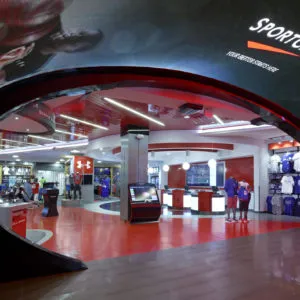Table of Contents
When Sport Chek, Canada’s largest sports retailer, expanded and redesigned its flagship store at the Yorkdale Shopping Center in Toronto, it created a shopping experience exemplifying what is necessary to thrive in today’s retail economy.
The brick-and-mortar store is a critical component of the omnichannel experience expected by tech-savvy consumers. It uses best-in-class technological features to seamlessly blend in-store and digital shopping, creating an “endless aisle approach.”
 “There is a lot of competition from online retail,” said Brenda Jones, a partner at Stoever Jones Design in Calgary, Alberta. “So how do you fight back? The store environment gives people the touchy-feely experience, but that alone isn’t enough. With the redesign, Sports Chek’s parent company, FGL Group, wanted to create more entertainment for people, as well.”
“There is a lot of competition from online retail,” said Brenda Jones, a partner at Stoever Jones Design in Calgary, Alberta. “So how do you fight back? The store environment gives people the touchy-feely experience, but that alone isn’t enough. With the redesign, Sports Chek’s parent company, FGL Group, wanted to create more entertainment for people, as well.”
The Yorkdale store delivers. A 40-foot ellipse with integrated LED lighting serves as a portal into the space, which went from 25,000 to more than 44,000 square feet. Curved podiums feature holographic displays while interactive kiosks allow customers to research and shop online from within the store.
There is technology to evaluate golf swings, and a treadmill analyzes how people run. An RFID tagging system connects every piece of footwear to a specialized display. Shoppers can place a shoe, and everything about the product and availability comes up on an integrated monitor. Throughout the store, 257 digital screens mounted on walls and installed into custom-built display tables provide a highly interactive, entertaining and empowered shopping experience.
The design challenge was to combine technology and merchandise into high-end sleek features while creating a unified look with clean lines and shapes. To accomplish this, FGL called upon established partnerships.
“We’ve worked with FGL for 20 years, as has Milltech Millwork in Edmonton,” Jones said. “With the client and Milltech, we developed all the fixtures. Many were designed from scratch. Then we handed them to Keith at Milltech to do his magic.”
Technology Supports Technology
Keith Waldbillig is the general manager and one of the founding partners of Milltech Millwork. The company specializes in complicated architectural millwork and works with clients throughout Canada and the United States. Its portfolio includes projects ranging in size from a single custom law office to Rogers Place, the Edmonton Oilers’ new NHL arena. Designed for multi-use and premium experience, the prestigious project is the first LEED-silver certified facility of its kind in Canada and received the ENR Global Best Projects Award of Merit, Sports/Entertainment, in 2017, among other accolades.
Milltech’s 85,000 square-foot facility is equipped for flexibility, primarily with Homag machinery. “We have CNC routers and case clamps. Beam saws and edgebanders. We have two of everything, so we have redundancy,” Waldbillig said. “It makes us more competitive and expands our offering.”

A press, guillotine and finishing department allow Milltech to lay up and stitch custom veneer panels. For countertops, the company has in-house v-grooving and solid surface fabrication equipment. Translucent resin panel processing and LED lighting capabilities round out Milltech’s repertoire.
Yet what brings in the bid invitations is Milltech’s engineering prowess, which exceeds its fabrication capabilities.

“We can take something as simple as a napkin sketch and draw all the 3D CAD work and engineering using Inventor software by AutoDesk. It was originally developed for metalworking. When we are done with the overall design, it gives us a cut-list and generates G-code for all the CNC parts for our millwork, even for compound curves or radial cuts.
“It integrates into our ERP system. Then the data for the same design goes to all the relevant trades on the project. No additional engineering necessary.” Waldbillig said. “We send blown-apart drawings for the installers, so when the parts come together on the job site, everything comes together precisely.”

Partnerships
Milltech’s engineering is a differentiator, but alone it is not enough to make the company immune to the threats of offshore competition, which also invests in similar equipment and can process the same programming.
“With 35 years in the industry, you learn how to build partnerships,” Jones said. “For Sport Chek, we do the project management, design development and code compliance. Material specifications come from the client, but we work with Milltech and their distributors to refine them to ensure the right material is used for each application.
“Sustainability is a big driver in this segment now. Lots of malls want materials to be Greenguard certified at the very least. It is also a fast-track market, so availability is key. We depend on our distributors to make sure our specifications meet those demands.”
Durability is always a factor in a high-traffic retail environment, and even more so in one designed to be interactive, like the Sport Chek flagship store at Yorkdale. HPL, phenolic-backed metallic HPL and solid surface are used widely throughout the displays and POS pods. Cabinetry is built from TFL. Rounded bulkheads serving as wayfinding devices are made from painted and hollowed out MDF.

The same basic palette used in the Yorkdale store carries over to all of Sport Chek’s redesigns, though sometimes the criteria and timeline vary based on location.
“We work with Upper Canada Forest Products, Formations and Richelieu to deliver materials that fit the design and comply with LEED, Greenguard or whatever a project requires. If anything happens during production or installation, they have replacements to us quickly. Having people willing to take some of the headache off your plate is a big boon in this industry. Speed to market gives us an advantages over foreign competition.”
Retail is a dynamic marketplace, forcing store brands to reinvent the shopping experience. Meeting the demands of continually evolving design concepts requires a strong interdependency between engineering/design and manufacturing.






